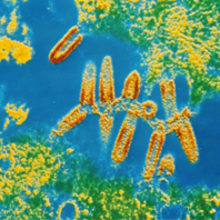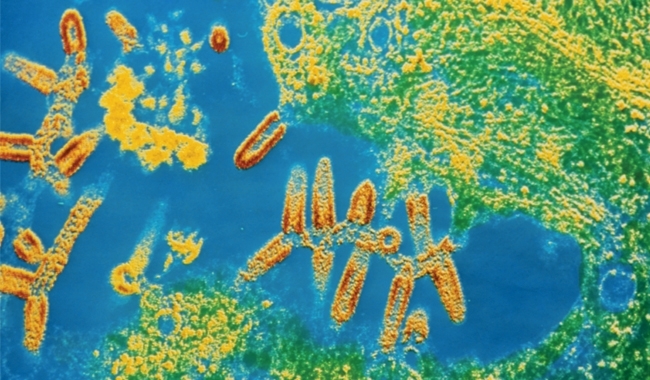Comment: Zoonoses in Africa
Issue: Zoonotic diseases
05 November 2015 article

Zoonotic diseases are those infections transmissible between animals and humans. Most diseases that infect humans are, in fact, zoonotic, highlighting that multi-host pathogens have a competitive edge by increasing the range of host environments in which they can survive. A recent briefing note by the Microbiology Society highlights that many zoonotic diseases are also emerging diseases – that is, either an altogether new disease, or a known disease that is increasing in incidence or increasing in geographical range.
Disease emergence happens because the world we (and our microbes) live in is changing (often because of the actions of humans, but also due to natural processes), giving pathogens new opportunities to infect new hosts, and creating new opportunities for hosts to interact with each other and share their infections. The intensification of farming, for example, leads to closer relationships between individual animals, generating opportunities for more rapid mutations as organisms move from host to host, while also providing a structured way for those pathogens to enter highly ordered food chains that branch out and reach very large numbers of people.
Zoonotic diseases are a global problem, with rich and poor countries both at risk, and practices in both highly developed and less developed economies predisposing to transmission. A significant difference, however, between a continent like Africa and one like Europe, is the ability of national and regional systems to detect and respond to zoonotic disease threats. Indeed, in work investigating where hotspots of disease emergence are located, developed countries stand out as being at higher risk, mainly only because more such events are detected in such places as a result of robust systems for monitoring and detection. Over the past couple of years, the struggle – now largely successful (but still not completed) – to contain the West African Ebola outbreak highlights this problem.
Other than the headline-hitting, large global outbreaks of zoonotic infections, human populations face a multitude of challenges from less dramatic, less fatal, diseases that cause long-term morbidity in large groups of people (morbidity refers to illness, as opposed to death, termed mortality). In Africa, several such zoonotic neglected diseases of neglected populations conspire to hinder the health of people and the animals they depend on for their livelihoods. This includes bacterial, protozoan and viral disease agents, transmitted in many ways.
The World Health Organization (together with its partners) has been keeping a focus on these diseases, with a series of reports and policy recommendations published since 2006 (with the latest having been released earlier this year). We’ll look briefly at three of them.
Cysticercosis is a disease caused by the tapeworm Taenia solium. It has a relatively complex lifecycle, involving pigs eating Taenia egg-carrying human faeces that contaminates the environment, humans eating undercooked pork meat, and environmental contamination with eggs that can encyst in humans. The greatest problem with T. solium is that it may cause a neurological disease called neurocysticercosis in people who are infected with tapeworm eggs; in many developing countries, it is the single largest cause of acquired epilepsy in humans.
Brucellosis is a bacterial disease caused by one of several organisms in the genus Brucella. Cattle, sheep and goats harbour this bacterium, which they transmit to each other and humans through milk or through contaminated abortion materials (the bacterium is abortogenic). It causes a chronic debilitating disease in humans with joint pain, fatigue and recurrent fever; brucellosis is often misdiagnosed as malaria and wrongly treated.
Rabies is a well-known but none-the-less neglected zoonotic infection, caused by the rabies virus. It is transmitted and maintained mostly in domestic dog populations (though in areas with a wildlife interface, the epidemiology may get more complex), which transmit the infection to humans through bites. It is best controlled by vaccinating the dog reservoir to prevent disease from developing if infection occurs, but a human vaccine is available both as a pre- and post-exposure course, and effective and timely delivery of the vaccine will minimise mortality.

For these diseases, and others like them, many aspects of their basic biology are well understood, and the transmission of the pathogens has been controlled in many countries. The outstanding issues, which require more research for the effective deployment of intervention efforts, are i) knowing how to integrate surveillance for the diseases into national systems (because having data on occurrence, distribution and disease burden is essential to prioritisation), ii) deploying, and in some cases developing, new and better tools to diagnose the infections in humans and animals (because accurate and efficient detection is key to both delivering cure and also to gathering good surveillance data), and iii) scaling up intervention strategies. The World Health Organization has stated that “we have existing knowledge and evidence that can be transformed into strategies and applied on a large-scale; we need to be able to capitalise on experience and the growing political commitment to involve other sectors, with community participation.”
Effectively tackling zoonoses requires a focus on transmission control, prevention and burden reduction in humans, but also control and transmission prevention in animals. This, in turn, requires a One Health approach, involving joint surveillance, joint control and joint policy management by veterinary, medical and other sectors. With respect to African countries, the weaker institutions that exist relative to many developing countries actually present a real opportunity in this regard, with greater possibility to strengthen those institutions with, in mind from the outset, a unified approach to disease management across sectors. Many efforts are under way to prime this process, and it is well under way in a number of places. A prime example of a One Health approach in action is the Zoonotic Disease Unit (ZDU) of the Government of Kenya, a joint initiative between the ministries responsible for human and veterinary health. It has, over the past few years, developed a highly regarded National Rabies Control Strategy, implemented large- scale studies to study brucellosis epidemiology, responded to many zoonotic disease outbreaks, and developed preparedness plans for epidemic zoonoses such as Rift Valley fever (for which 2015 is a high risk year due to unusual rainfall patterns). The ZDU is also very open to collaboration with research teams working in Kenya, including in the implementation of zoonotic disease surveillance activities.
Tackling zoonoses is a difficult, fascinating task; it requires a good understanding of biology, of the way environment influences disease, of human–animal interactions, of policy and of politics.
ERIC FÈVRE
Professor of Veterinary Infectious Diseases, Institute of Infection and Global Health, University of Liverpool, Leahurst Campus, Chester High Road, Neston CH64 7TE, UK, and International Livestock Research Institute, Old Naivasha Road, PO Box 30709-00100, Nairobi, Kenya
[email protected]
www.zoonotic-diseases.org
Image: False-colour transmission electron micrograph of rabies virions (red, elongated virus particles) budding away from host cell cytoplasm. CNRI/Science Photo Library..
